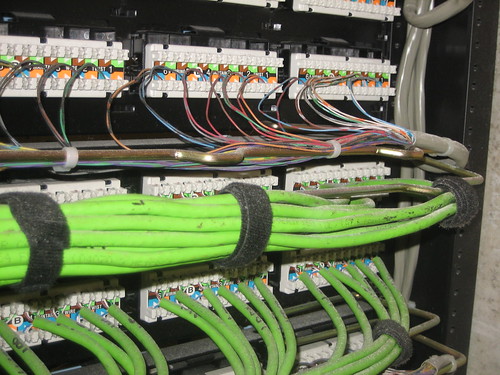Whether you're a network administrator, systems administrator, cable monkey, or general IT grunt, there are a few professional skills that are indispensable in order to prosper. Sure, you can survive being surly and bitter, but to reach your full potential, it would be wise to take this list into consideration.
10) When something is broke, fix itThis can be as simple as a loose cable end, or as complex as an inefficient process. It's not your bailiwick to fix every problem in the entire infrastructure (then again, maybe it is), but an eye for improving things is highly appreciated in the right sort of company. If you see a way to improve something, talk to the appropriate people to see what can be done. You are part of the company, and by improving the whole, you're making things better for yourself, too.
9) Manage your time efficientlyTom Limoncelli's book
"Time Management for System Administrators" goes far more into detail than I can here, and the book is not just for sysadmins, despite the title. To summarize an important point, keep track of what you have to do, and when you have to do it. It's either due right now, it's due soon, or it's due later. If you categorize by those identifiers, you'll never have something sneak up on you.
8) Learn from people who know more than you Discovery of new things on your own is exciting. You're full of wonder when you chance upon an unfamiliar subject. It's no doubt similar to the feeling Magellan or Columbus had. Like those people, you too are probably discovering something that other people have known about for a long, long time. While you should never stop exploring on your own, never be too proud to learn from the people who have been there before you. Even the guy who invented calculus stood on the shoulders of giants. You might be able to borrow someone's stepladder, anyway.
7) Organization shall set you freeThere are people who have to keep track of lots and lots of things. Some of those people are librarians, and they use something called a Dewey Decimal System to manage thousands of discrete items. If you've ever wandered through a library just glancing at shelves, you've probably been amazed by how bizarre some of the book groupings can be. Despite the seemingly random categories, any librarian worth their salt can tell you where a book is filed in a moment's notice. That's because, despite what you or I might think of their cataloging system, it works. I'm certainly not suggesting the Dewey Decimal System for your network documents / asset tracking, but it's important that you have a system that you know how to use, and that it's one which works for you. A pile of papers isn't a system, and neither is throwing everything in the root of your home directory. Make it easy to find data that you need, and use the tools at your command to make it happen.
6) Pick your fightsYou probably work with at least one other person. If that person is in IT, you'll probably disagree as to the best course of action. If that person is not in IT, it's almost certain that you'll disagree about the best course of action. As IT workers, we're exposed to a large amount of data, some of which is so obscure or esoteric that I'm tempted to call it trivia, however the lump sum of that data, when added to our experience becomes knowledge, and we use this knowledge to make judgments about procedures that other people might think are arbitrary decisions. Example: It's a bad idea to run CAT5 along the power conduit that feeds the florescent lights. It just is. We could explain why, but the person who wanted to do it wouldn't care why we refused. They just know that they aren't going to get their network cable. Discussions of this nature will be more or less serious, depending on the day and the phase of the moon. When it comes to the less serious discussions, my advice to you is identical to the advice that someone very wise gave me about my then-upcoming wedding. When the two of you disagree, go along with whoever cares more. If it's a bad idea, and the person knows that, but really really wants it, maybe you should consider giving it to them. Maybe.
5) Competence is next to GodlinessI was at Chipotle the other day, and I saw a 12 year old Honda with a completely useless rear spoiler that rose a foot above roof height. My initial thought was "I bet that guy doesn't race his car". Why not? Because he's just showing off; there's no substance behind his style. You can talk as big as you want about your skills, but unless they're real, it's all hot air. Always seek to increase your competency rather than people's opinion of you. If you succeed in the first, the second will follow.
4) Be honest...enoughAh, honesty; you wear so many guises. There are laws against certain kinds of dishonesty. There are societal mores that frown upon others. Then, there is a certain kind of etiquette that requires a bit of fudging the truth. It's important to realize that people sometimes need to be let down gently, particularly when they're proud of something they did, or think they did, when in fact, they've screwed the pooch, so to speak. Honesty is also important when something breaks, though it's probably more important to know that the finger you use to point to the cause would be better used to fix the problem.
3) Take responsibility Just as important as not pointing fingers at other people is recognizing when, through some fault of your own, something has gone to hell and someone else noticed. I've honestly never seen a member of management more amazed than when someone stood up, looked them in the eye, and took full responsibility for the problem. Worming your way out of a jam is a time honored tradition, and taking the opposite stance will confuse and confound those to whom you plead. An honest apology coupled with an assurance of future improvement, and perhaps a quick overview of that path, is the surest way to gain respect from people who are used to seeing the worst of people.
2) Be a team playerSometimes, on occasion, and I must emphasize the rarity of this event, it is not all about you. In this instance, you might be part of a multi-department ninja-strike-team, or maybe you've been assigned a partner to get a major issue taken care of, but whatever the particulars, in dire times such as these, someone else is involved in the task at hand. When you inevitably succeed (is there another option?), to the victors go the spoils. In this case, it might be a raise, or more likely, a congratulatory email. The proper reaction is, despite how weasely your teammate(s) might have been, to share the responsibility of success. In fact, I've found that a good rule of thumb is to never assume more responsibility for success than the amount of blame you would have ascribed to your partner(s) if the project had failed.
1) Have an exit strategy It's sad, but not all of our endeavors end in unblemished success. In fact, some times, they just up and fail. We're talking real end-in-fire type stuff here. You can usually tell when something like this is going to happen, because you find yourself pushing towards a solution that shows no sign of yielding to your will. Lots of times, you'll make little bits of progress as large sections of time leap by. You approach the deadline with no real progress to show, and your choice is to present a half (if you're lucky) finished product, or hack together some kludge that doesn't pass muster and hope you can fix it later while no one notices. Neither of these options is particularly appealing, so it's important to set a limit for yourself. If it's not 80% by this date (where "this date" is a decent amount of time ahead of the deadline) then we're going with Plan B. Of course, this necessitates having a Plan B, but I think that's a good idea regardless of what activities you're engaged in.
I certainly didn't cover everything you need, but I got some of the big ones, I think. If you disagree, or have more to add, please comment! If you liked the list, feel free to Digg it. If you're tired of these stupid lists of things, drop me a line at standalone.sysadmin@gmail.com and let me know.











